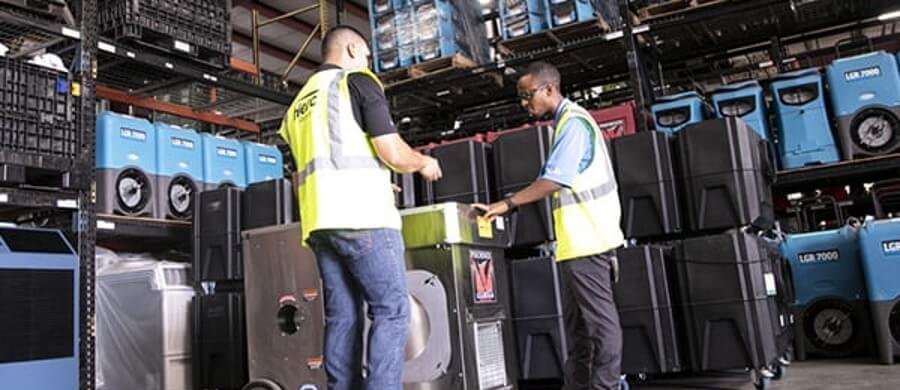
Whether you are managing a construction site, factory, warehouse, or other project site, you need your operations to run smoothly, but there is one variable you can never control: the weather. With some planning and the right heater, you can help prevent the effects of cold temperatures from snowballing.
Equipping your project site with an effective commercial or industrial heater can keep your team safe and warm, minimize expensive delays and rework, and help ensure that your team can meet project needs. Here, Herc Rentals explores why climate control is important for many project types and what you need to consider when selecting a temporary or supplemental heating solution for your project.
The Importance of Climate Control
Complex projects require careful coordination of multiple teams and resources to ensure everyone’s safety. You also need to make sure the project stays on schedule and within budget. If one step goes wrong or is delayed, your entire project could fall behind.
Weather can have a major impact, especially if you are working in winter or if there is a sudden cold snap or freezing temperatures. Frozen ground can slow down foundation work. Fluctuating temperatures and humidity can warp materials and delay cure times, leading to inconsistent results and rework. Plus, some equipment cannot be operated effectively in colder temperatures, further delaying your project.
Winter weather can also affect your workers’ productivity and safety. Slippery surfaces and the need to wear more layers, like bulky coats and gloves, can increase the likelihood of accidents and injuries.
Climate control solutions, such as a heater, can help ensure your workers stay comfortable and the work stays on track. In fact, heating your project site may even be required by law as part of maintaining a safe workplace. The Occupational Safety and Health Administration (OSHA) and the National Institute for Occupational Safety and Health have guidance and resources on protecting workers.
See the Occupational Safety and Health Administration’s Emergency Preparedness Guide on cold stress: https://www.osha.gov/emergency-preparedness/guides/cold-stress
Learn more about the signs and symptoms of cold-related illnesses, as well as tips for staying safe in cold weather, from the National Institute for Occupational Safety and Health: https://www.cdc.gov/niosh/cold-stress/about/?CDC_AAref_Val=https://www.cdc.gov/niosh/topics/coldstress/default.html
How to Choose the Right Heater
1. Know the types of construction heaters and how they work. The first step in choosing a heater for your project site is to familiarize yourself with the types of heaters available. Understanding how different types of heaters work will help you determine which one is the best choice for the productivity and safety of your team.
Direct-Fired Heaters
Direct-fired heaters are fuel-efficient and can warm a very large area quickly by using fuel to create a flame. The flame itself warms the air, while a fan disperses the warm air over a large area. Direct-fired heaters are easy to use and do not require much maintenance.
However, a direct-fired heater does not have a fully enclosed flame. The warm air it produces will contain byproducts of the fuel and may add moisture to the air. You should only use a direct-fired heater in an outdoor or well-ventilated area, away from the public or animals. Direct-fired heaters may be prohibited in some locations. Be sure to check your local laws and regulations.
Indirect-Fired Heaters
Like a direct-fired heater, indirect-fired heaters also use fuel combustion to generate a large amount of warm air quickly. However, the flame produced by an indirect-fired heater is fully enclosed within a combustion chamber. In this way, indirect-fired heaters act like a mobile furnace, circulating air through delivery and return air ducting so that the dry, warm air released at your project site is free of fumes. Indirect-fired heaters can be used in enclosed areas, but they may require an external power source, and they have a larger footprint than direct-fired heaters.
Self-Contained Heaters
Unlike direct- and indirect-fired heaters, which warm up a broad area, self-contained heaters are ideal for localized heating needs. Self-contained heaters can be powered by electricity, gas, diesel, or oil and often have their own generator. Without the need for auxiliary power, you can use self-contained heaters on remote projects for a variety of targeted heating needs, such as thawing ground, warming a specific work area, or temporarily heating a space where traditional heating systems are not feasible.
Herc Rentals offers a wide range of direct-fired, indirect-fired, and self-contained heaters.
2. Choose the fuel options that meet your safety and efficiency needs. Now that you know what types of heaters are available, you can narrow your options down by fuel type. A good place to start is by reviewing the regulations of the city where the project is located. Some cities or neighborhoods restrict the types of fuel sources you can use and may require you to choose a heater that uses only diesel or electric power.
If there are no restrictions on fuel type, then consider the safety and efficiency needs of the worksite. Check OSHA’s guidelines for temporary heating devices to determine how much clearance and ventilation you will need before selecting a fuel type.
Read OSHA’s guidance on temporary heating devices here: https://www.osha.gov/laws-regs/regulations/standardnumber/1926/1926.154
- Electric heaters have minimal risk of fire and are easy to set up, but they may require access to three-phase high-voltage electrical outlets and may cost more to run than propane or natural gas heaters.
- Natural gas heaters and propane heaters run on tanks of fuel and may cost less than all-electric heaters to run, but the site will need adequate space to ensure fire safety and ventilation.
Fuel and electricity costs are always fluctuating, so be sure to factor in how much it will cost to fuel and run the heater for the duration of your project. For instance, if you choose to rent a heater, approximately 20 percent of the associated costs will be for equipment rental and 80 percent for fuel.
3. Consider how you will use the heater. Temporary heaters are a great option for when you need extra warmth for the duration of an entire project or just for a specific task. Understanding where, when, and exactly how your team will use the heater can help you identify specific features you need in a commercial heater.
- Cure materials or prevent frost: If your project needs to cure materials, warm concrete, or thaw the ground, then a portable self-contained ground heater, such as Herc Rentals’ 1.0M BTU self-contained heater, 3.1” static pressure, diesel, with multiple zones could be the best choice.
- Ensure sites are warm before work begins: Some heaters can be turned on remotely or have advanced scheduling capacity that allow teams to plan ahead and have the site warmed up by the time workers arrive, such as Herc Rentals’ 1.0M BTU self-contained heater, 7.5” static pressure, diesel unit.
- Flexibility: If you need to regularly adjust fuel usage or your jobsite temperature, look for a heater with adjustable fire settings or fuel selectors, such as the 1.5 million BTU direct-fired heater LPG (liquid petroleum gas)/NG (natural gas) from Herc Rentals.
- Rapid deployment, access to the newest equipment, or cost savings: Sometimes, the need for temporary heating arises quickly and you need access to the latest equipment without the burden of high upfront costs and ongoing maintenance that comes with purchasing a heater. In these cases, renting a heater benefits both your schedule and your budget.
For more information, visit www.hercrentals.com.


